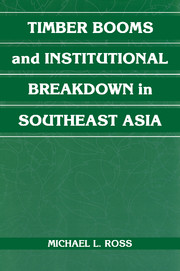Book contents
- Frontmatter
- Contents
- Illustrations
- Tables
- Preface
- 1 Introduction: Three Puzzles
- 2 The Problem of Resource Booms
- 3 Explaining Institutional Breakdown
- 4 The Philippines: The Legal Slaughter of the Forests
- 5 Sabah, Malaysia: A New State of Affairs
- 6 Sarawak, Malaysia: An Almost Uncontrollable Instinct
- 7 Indonesia: Putting the Forests to “Better Use”
- 8 Conclusion: Rent Seeking and Rent Seizing
- Appendix: Chronologies of Events
- References
- Index
3 - Explaining Institutional Breakdown
Published online by Cambridge University Press: 30 July 2009
- Frontmatter
- Contents
- Illustrations
- Tables
- Preface
- 1 Introduction: Three Puzzles
- 2 The Problem of Resource Booms
- 3 Explaining Institutional Breakdown
- 4 The Philippines: The Legal Slaughter of the Forests
- 5 Sabah, Malaysia: A New State of Affairs
- 6 Sarawak, Malaysia: An Almost Uncontrollable Instinct
- 7 Indonesia: Putting the Forests to “Better Use”
- 8 Conclusion: Rent Seeking and Rent Seizing
- Appendix: Chronologies of Events
- References
- Index
Summary
Why do windfalls lead to policy failures? Since the 1950s, scholars have offered two types of explanations: cognitive explanations, which suggest that windfalls induce either laziness or euphoria among policymakers; and societal explanations, which suggest that windfalls encourage nonstate actors – such as interest groups, political clients, and rent seekers – to demand a share of the windfall from the state.
This chapter begins by summarizing these two approaches. It then describes my own explanation, which is that resource booms lead to rent seizing by state actors. It explains some of the assumptions behind the concept of rent seizing, how it may hurt institutions, how it differs from other types of rent seeking, and how it is influenced by a state's regime type. The chapter concludes by explaining how and why I use the cases of the Philippine, Malaysian, and Indonesian timber sectors to illustrate my argument.
COGNITIVE EXPLANATIONS FOR WINDFALL POLICY FAILURES
Cognitive approaches suggest that windfalls produce a type of myopia among public or private actors, which in turn leads to institutional or policy failures. Some observers imply that windfalls lead to myopic sloth; others argue that windfalls produce myopic exuberance. Wallich (1960) and Levin (1960), for example, argued that periodic commodity booms in sugar-exporting states led to careless economic planning, which inhibited export diversification.
- Type
- Chapter
- Information
- Publisher: Cambridge University PressPrint publication year: 2001



